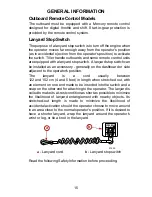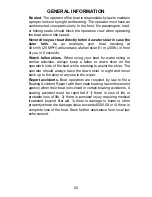
GENERAL INFORMATION
20
The primary concern is the boat changing direction while in the
midst of the jump. In such case the landing may cause the boat to
veer violently in a new direction. Such a sharp change in direction
can cause occupants to be thrown out of their seats, or out of the
boat.
!
WARNING
Avoid serious injury or death from being thrown within or out of
a boat when it lands after jumping a wave or wake. Avoid wave
or wake jumping whenever possible. Instruct all occupants that
if a wake or wave jump occurs, get low and hang on to a boat
hand hold.
There is another less common hazardous result from allowing your
boat to launch off a wave or wake. If the bow of your boat pitches
down far enough while airborne, upon water contact it may
penetrate under the water surface and submarine for an instant.
This will bring the boat to a nearly instantaneous stop and can send
the occupants flying forward. The boat may also steer sharply to
one side.
Impact With Underwater Hazards
Reduce speed and proceed with caution whenever you drive a
boat in shallow water areas, or in areas where you suspect
underwater obstacles may exist which could be struck by the
outboard or the boat bottom.
The most important thing you can
do to help reduce injury or impact damage from striking a
floating or underwater object is to control the boat speed.
Under these conditions, boat speed should be kept to a
minimum planing speed of 24 to 40 km/h (15 to 25 MPH).
ob00315
Содержание 200 VERADO
Страница 4: ...iv ...
















































